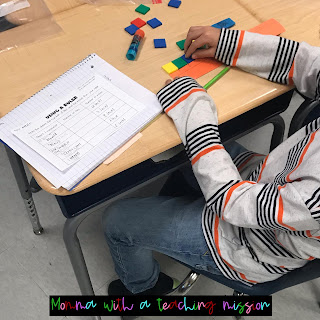After two marking periods of place value, adding and subtracting three digit numbers, our third marking period starts with measuring. Measuring lends itself nicely to a variety of read alouds! I admit that every book I recommend for this unit, I own!
Our first unit in our third marking period covering three standards. In Maryland, we follow the Common Core State Standards and those that we cover are 2.MD.1, 2.MD.2, 2.MD.3. 2.MD.1 is measuring the length of an object by selecting and using appropriate tools such as rulers, yardsticks, and measuring tapes. 2.MD.2 is measuring the length of an object twice, using length units of different lengths for the two measurements; describing how the two measurements relate to the size of the unit chosen. 2.MD. 3 is estimating lengths using units of inches, fee, centimeters, and meters.
To 'kick-off' our unit on measurement, we read 'Inch by Inch' by Leo Lionni and then students made posters about items that were about 1 inch long.
The next day we created inch rulers by using sentence strips (which I halved vertically and then cut into 12 inch strips) and we lined up 12 square array tiles, which just so happen to be 1 inch square! The following day we used our rulers to measure different items in the classroom, but estimated them first!
The next two day we discussed how 12 inches equals 1 foot, and then 3 feet equals 1 yard. We also read the book Super Sandcastle Saturday (a Math Start book). We used yardsticks and rulers.
We measured baskets of stuff, and they had items of things they had to decide which unit of measure they should measure with--inches, feet, or yards.
We then read the story How Big is a Foot (Rise and Shine), and we talked about standard units of measure being the same everywhere. The reason we don't use actual feet is because our feet are different sizes. Then the students did an activity with making a bed for the apprentice. We didn't have enough room in the classroom for this, so we moved into the hall!
The next lesson we got out the measuring tapes and read a very fun story, Jim and the Beanstalk, which mentions beer on one page, so I to cover the word beer with my finger and change it on the fly when I was reading, because I had forgotten it said that! We then used the measuring tapes to measure different items in the room.
The next lesson we switched gears and I introduced centimeters. We read the Math Start book Pollys Pen Pal and we discussed the English System of measuring versus the Standard System of measuring. We then used the ones units from our base ten blocks, to create centimeter rulers (because those ones units are the size of centimeters!).
The next few lessons looked similar to the inch/feet/yards lessons. We measured different items with centimeters, talked about 100 centimeters equaling 1 meter, and used the reverse side of the measuring tapes to measure in centimeters.
Here's some other great literacy connections to read to kick off, or hook, your mathematics at the start of your math lesson. Math Counts Length, Let's Measure It, How long or how wide, Is a Blue Whale the biggest thing there is?, If you Hopped like a frog, Biggest strongest fastest
For our summative assessment, I created a project based activity. My students love dogs, so we started by reading Measuring Penny. They then were assessed on the three standards that we had devoted so much time on!
The students got to pick two dogs to compare and then decide which size dog houses they would need based off the dogs measurements and the dog house measurements. They also had to measure some chew toys, think about reasonable measurements, and measure dog houses.
If you are interested in my project based learning activity with dogs and their measurements, make sure you check out:
Or if you are interested in the activities and recording sheets mentioned in this blog be sure to check out:


























No comments